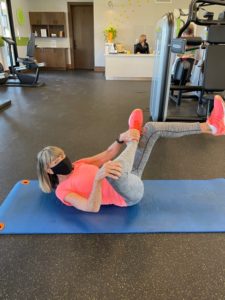 What is your least favorite exercise? For me it is stretching and balancing. I think it’s because both require holding a pose over time. It’s static. It requires patience. I want to move when I exercise, get my heart pumping, and challenge myself with repetitions and weights.
What is your least favorite exercise? For me it is stretching and balancing. I think it’s because both require holding a pose over time. It’s static. It requires patience. I want to move when I exercise, get my heart pumping, and challenge myself with repetitions and weights.
Just standing there on one foot or lifting a leg up on a bar seems so passive. I get bored. I’m not alone among seniors. Many of us hardly ever devote workout time to stretching and balancing. And yet, it’s a fact that if we don’t develop flexibility our joints suffer and we are more prone to injury.
Why Stretching and Balancing Is Crucial
An important element in aging well is being active. Not just in the gym and in sports, but so many social outlets involve being able to move freely. You can’t drive or move around with back, hip, knees or leg injuries.
Falls are a serious mortality risk for seniors, because being immobile leads to other degeneration. The statistics are dreadful. In the United States, falls are the leading cause of fatal and nonfatal injuries among older adults. In fact, one out of three people aged 65 and over will have a serious fall.
Once a person has had a fall, they are more likely to fall again. Falls often cause injuries. Some of the injuries, such as a broken hip, can be serious. Older people are more likely to break bones in falls because many older people have porous, fragile bones (osteoporosis).
When a senior is injured, they are less likely to return to activities such as exercise. That leads to a downward spiral in health. Some reports show that up to 50% of patients with hip fracture die within six months and many of those who survive do not recover their baseline independence and function. In recent decades the increase in life expectancy after 60 years of age has led to an exponential growth in hip fractures.
For me, that’s good enough reason to increase stretching and balancing exercises, especially to strengthen legs and hips. As active as I am between sports, gym workouts and biking, I’ve fallen several times in the last five years. I’ve fallen on the tennis courts, pickleball courts, and walking down the street! Fortunately, I’ve never broken a bone or sprained a joint (yet). I attribute that to my workout routines. Exercise strengthens bones and stretching allows muscles, tendons, and ligaments the ability to catch yourself to avoid serious injury when falling. Of course, I’m knocking on wood as I say these things, because nothing is forever.
Stretching and Balancing: Bare Minimum Workouts
Here are the key areas to stretch. If you add these into your daily routine, you can kill two birds with one stone. Just do 30 seconds of stretching on each body part as a warm up for your dynamic exercises.
- Neck
- Shoulders
- Back
- Hips
- Legs
Proper static stretching doesn’t involve movement, so no bouncing. If you bounce and try to stretch muscles when they are cold you risk pulling something. So don’t do these straight out of bed. After a hot shower is better.
If you want a good guide with illustrations of stretching and balancing exercises, I recommend the book Stretching for Beginners, Improve Flexibility and Relieve Aches and Pains with 100 Exercises and 25 Simple Routines, by Natasha Diamond-Walker.



Hi Patsi – I hope all is well with you and Rob. Thanks for this information about stretching. I’m in my fifth week of recovering from a fall at home that resulted in strain and sprain to ligaments and tendons in my lower leg, not to mention swelling of the ankle. I’m going to order the book you recommended! Aging is not for wimps…
A yay yay! Sorry to hear about your fall. And glad it wasn’t worse. Rob is doing better with his medical treatments, and probably because he was so strong and fit before the cancer. We’re hoping for a remission, but it’s tough. At least he’s back to writing books and has one coming out soon: a graphic novel for young adults. Stay tuned for our 2nd book on Aging Well.